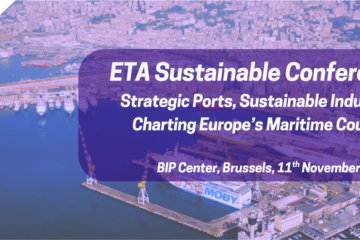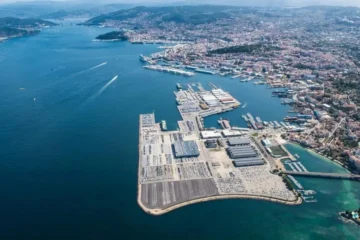The European Tugowners Association (ETA) favours initiatives that would help decarbonise and mitigate the effects of climate change. Indeed ETA supports and shares the ambitions of the European Union for 2050 in terms of the Green Deal.
Nonetheless, ETA notes that the ETS emissions scheme for the maritime sector, which will come into force on the 1st of January 2024, will severely impact several ports on Europe’s peripheries.
One of the scopes of this regulation is to reduce CO2 emissions and adopt a polluter-pays approach, thus intrinsically rewarding those shipping companies that have embarked on decarbonisation as early adopters. However, as reality demonstrates, this scope will only be partially reached since shipping lines are trying to circumvent this tax at the cost of European port competitiveness, employment and investment.
Carbon emissions leakage
In specific regions such as the Mediterranean, European ports act as hubs for transhipment activities. With the introduction of the ETS, it will be more attractive for transhipment to visit non-EU ports since they would either pay 50% of ETS or none at all. All this while still polluting. Hence, European ports, such as in the Mediterranean, will lose transhipment activities to other ports in North Africa but will still be in an area with shipping pollution. With the consequence of not being able to utilise any tax collected for these shipping lines, which will be polluting all the same. Moreover, carbon emissions are likely to increase because longer distances will be required to be covered by feeders from new North African hubs towards European ports, which will no longer be served by direct services.
Reduced competitiveness
The ETS for the maritime sector will reduce the competitiveness of specific ports within Europe. Once it is cheaper to use hubs in North Africa or the UK, because of no or low ETS, EU ports, which were hubs, will lose their competitiveness as they will no longer be attractive as hubs. In many cases, once transhipment is shifted from EU ports, if the level of residual “domestic” cargo destined for EU ports becomes insignificant, the port is dropped from the itinerary of the mega-carrier with catastrophic consequences on the direct connectivity opportunities for that port and industry around its hinterland. This also raises risks on the protection of supply-chains into Europe.
The aspect of competitiveness in the Mediterranean region is not a new subject. The Mediterranean basin has always been considered unique in view of the threat of North African ports.
Reduced investment
Ports have their investment plans to ensure resilience, competitiveness and sustainability. However, the threat of losing competitiveness will inevitably slow down or stop such investment. Indeed, such is the cost advantage that has been awarded to non-EU ports, that shipping lines have rushed to invest in added and new transhipment capacity in North Africa, most notably in Egypt and Morocco. The new investment in these countries is being made at the detriment of EU Ports where investment projects have been put on hold in contrast to Europe’s efforts to support a just transition and climate change mitigation.
Furthermore, these ports shall not only lose transhipment activities currently in their ports (hence an economic setback – without the reduction of shipping emissions); they will also not be able to benefit from the money collected from ETS, which would otherwise be used for climate change mitigation.
Employment
A natural consequence of loss of competitiveness and fewer transhipment calls within ports will be the loss of employment. Ports, port services, and freight logistic companies will be faced with lesser work, and consequently, a natural development would be laying off people.
The effect of this would be devastating not only for the economic operators but for entire port regions that are often located in under-developed regions which depend on port activities for employment and prosperity and which typically qualify for high state-aid intensities.
It is, therefore, for this reason that the European Tugowners Association (ETA) joins several other stakeholders in a call on the European Commission to be cautious and thoroughly consider the full economic and social impact ETS will be having on specific regions in Europe before the damage becomes irreversible.
Hence the ETA recommends the following actions:
- Carry out first an in-depth impact study of specific vulnerable regions and ports in Europe, particularly the Mediterranean and the North Sea prior to implementing the ETS scheme in the maritime sector.
- Alternatively, we advise suspending charging ETS to transhipment, which does not originate in the EU and is not destined for the EU but uses the EU ports as hubs or transiting ports of call. During this period, the European Commission should conduct a thorough ex-ante impact assessment of these regions to ensure that the diversion of traffic (and, therefore, carbon emission leakage) is mitigated and that competitiveness is preserved. It is pertinent to note that once decisions are made to invest in a non-EU port with a view to transferring operations from EU ports, these decisions are permanent and irreversible. Its evaluation must not only consider current transhipment volumes but must also take into account the future transhipment capacity in other neighbouring ports. The ETA notes that in introducing the Transhipment Rule as a “corrective” measure in recent months, the Commission only considered the threat of evasive behaviour posed by 2 current ports – namely East Port Said (Egypt) and Tanger Med (Morocco).
- Consult the various stakeholders in the regions mostly at risk to arrive to an ETS regime which is fair and which penalises the polluter without jeopardising competitiveness.
- Ensure a level playing field globally, using its clout at the IMO level to implement ETS at a global level. The aim of ETS would be realistically achieved if implemented at a global level, Thus, the potential but immediate negative effect ETS currently has on EU ports will be removed since all ports would be on a level playing field.
Finally, ETA notes that whereas an impact assessment was carried out in 2020 on the ETS, very limited parts of this impact assessment have been dedicated to the diversion of traffic. This aspect has only been considered from the standpoint of carbon leakage and not from a wider socio-economic perspective.
ETA once again reiterates its support for decarbonisation and the goals European Green Deal goals and is always willing and ready to cooperate with policymakers and stakeholders to achieve these goals.



0 Comments